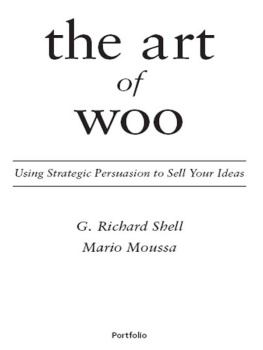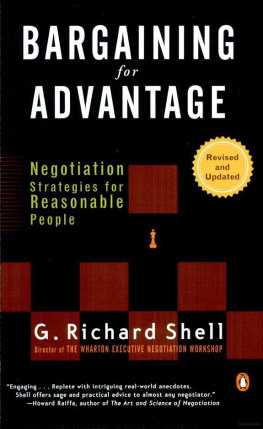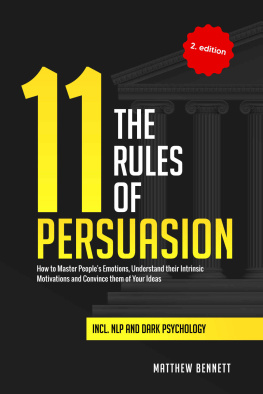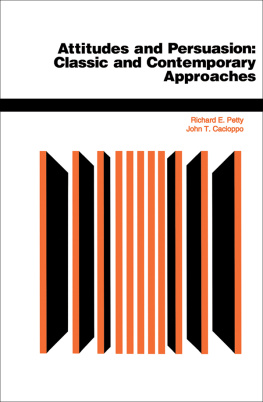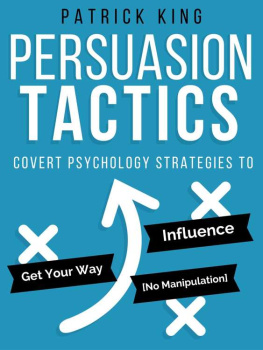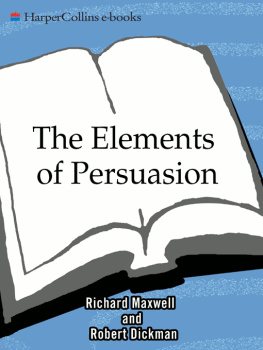G. Richard Shell - The Art of Woo: Using Strategic Persuasion to Sell Your Ideas
Here you can read online G. Richard Shell - The Art of Woo: Using Strategic Persuasion to Sell Your Ideas full text of the book (entire story) in english for free. Download pdf and epub, get meaning, cover and reviews about this ebook. year: 2007, publisher: Portfolio, genre: Romance novel. Description of the work, (preface) as well as reviews are available. Best literature library LitArk.com created for fans of good reading and offers a wide selection of genres:
Romance novel
Science fiction
Adventure
Detective
Science
History
Home and family
Prose
Art
Politics
Computer
Non-fiction
Religion
Business
Children
Humor
Choose a favorite category and find really read worthwhile books. Enjoy immersion in the world of imagination, feel the emotions of the characters or learn something new for yourself, make an fascinating discovery.
- Book:The Art of Woo: Using Strategic Persuasion to Sell Your Ideas
- Author:
- Publisher:Portfolio
- Genre:
- Year:2007
- Rating:5 / 5
- Favourites:Add to favourites
- Your mark:
- 100
- 1
- 2
- 3
- 4
- 5
The Art of Woo: Using Strategic Persuasion to Sell Your Ideas: summary, description and annotation
We offer to read an annotation, description, summary or preface (depends on what the author of the book "The Art of Woo: Using Strategic Persuasion to Sell Your Ideas" wrote himself). If you haven't found the necessary information about the book — write in the comments, we will try to find it.
The Art of Woo: Using Strategic Persuasion to Sell Your Ideas — read online for free the complete book (whole text) full work
Below is the text of the book, divided by pages. System saving the place of the last page read, allows you to conveniently read the book "The Art of Woo: Using Strategic Persuasion to Sell Your Ideas" online for free, without having to search again every time where you left off. Put a bookmark, and you can go to the page where you finished reading at any time.
Font size:
Interval:
Bookmark:

Using Strategic Persuasion to Sell Your Ideas
Mario Moussa
Portfolio
PORTFOLIO
Published by the Penguin Group
Penguin Group (USA) Inc., 375 Hudson Street, New York, New York 10014, U.S.A.
Penguin Group (Canada), 90 Eglinton Avenue East, Suite 700, Toronto, Ontario, Canada M4P 2Y3 (a division of Pearson Penguin Canada Inc.) Penguin Books Ltd., 80 Strand, London WC2R 0RL, England Penguin Ireland, 25 St. Stephens Green, Dublin 2, Ireland (a division of Penguin Books Ltd) Penguin Books Australia Ld, 250 Camberwell Road, Camberwell, Victoria 3124, Australia (a division of Pearson Australia Group Pty Ltd) Penguin Books India Pvt Ltd, 11 Community Centre, Panchsheel Park, New Delhi110 017, India Penguin Group (NZ), 67 Apollo Drive, Rosedale, North Shore 0632, New Zealand (a division of Pearson New Zealand Ltd) Penguin Books (South Africa) (Pty) Ltd, 24 Sturdee Avenue, Rosebank, Johannesburg 2196, South Africa
Penguin Books Ltd, Registered Offices:
80 Strand, London WC2R 0RL, England
First published in 2007 by Portfolio, a member of Penguin Group (USA) Inc.
Copyright G. Richard Shell and Mario Moussa, 2007
LIBRARY OF CONGRESS CATALOGING-IN-PUBLICATION DATA
Shell, G. Richard,
The art of woo : using strategic persuasion to sell your ideas / G. Richard Shell & Mario Moussa.
p. cm.
Includes bibliographical references and index.
ISBN: 978-1-1012-0251-7
1. Selling. 2. Marketing. 3. Persuasion (Psychology) I. Moussa, Mario. II. Title.
HF5438.25.S48 2007
658.85dc22 2007029601
Without limiting the rights under copyright reserved above, no part of this publication may be reproduced, stored in or introduced into a retrieval system, or transmitted, in any form or by any means (electronic, mechanical, photocopying, recording or otherwise), without the prior written permission of both the copyright owner and the above publisher of this book.
The scanning, uploading, and distribution of this book via the Internet or via any other means without the permission of the publisher is illegal and punishable by law. Please purchase only authorized electronic editions and do not participate in or encourage electronic piracy of copyrightable materials. Your support of the authors rights is appreciated.
For Robbie, always.
For Robin, Ella, Miles, and Bix.
Woo?
Whats Woo?
Were glad you asked.
Marcus Buckingham and Donald Clifton, in their best-selling book Now, Discover Your Strengths, tell us that woo is a talent for W inning O thers O ver. The Wall Street Journal recently reported that Barbara Broccoli and her half brother Michael Wilson, part-owners of the James Bond movie franchise, wooed business tycoon Sir Richard Branson to be a partner in their latest James Bond film. On that same day, according to other news reports, President Hu of China arrived in India to woo officials there on his plans for regional cooperation, and the Central Kenya Initiative was formed to woo voters in that African region. Meanwhile, officials from a small southern city traveled to Las Vegas, Nevada, to woo shopping center developers into locating a mall in their city, and a major British university introduced a new program to woo corporate recruiters to its campus. Around the world, in places too numerous to name, people were wooing their bosses, town councils, colleagues, and spouses to adopt their latest plans to improve lives and solve difficult problems.
So what is Woo? It is relationship-based persuasion, a strategic process for getting peoples attention, pitching your ideas, and obtaining approval for your plans and projects. It is, in short, one of the most important skills in the repertoire of any entrepreneur, employee, or professional manager whose work requires them to rely on influence and persuasion rather than coercion and force.
Woo. Simple to say. Hard to do.
A manager we know once lobbied for a bigger-than-normal raise by sending his boss a detailed e-mail listing all his recent accomplishments. The boss circulated the e-mail to the senior staff and asked for comments. One of the executives copied on the e-mail was offended by what he saw. It appeared to him that the manager was taking the credit for a major project that the executive thought he should get the credit for. A flurry of e-mails followed. Long story short: our friend did not get his raise. Instead, he was fired for not being a team player.
He lost his job because he ignored the ever-present danger of office politics and forgot that idea-selling campaigns begin with relationships, not e-mails. Lacking tone and context, e-mail messages are easy to misinterpret. You cannot control who will see them, and they are never deleted. If you want to get people on your side, go meet with them face-to-face and see firsthand how they react to your ideas. Then use e-mail later, after they are already on your team.
Woo is about people, not saving time.
Woo and You
Woo starts with a look in the mirror. If you do not know your own goals, biases, emotions, and preferences, you cannot hope to see your audience clearly. With this self-awareness as a foundation, you gain the perspective needed to focus on the people you are trying to persuade. If you look up the word woo in the dictionary, you will find that the first definition relates to romantic courtship, as in Charles wooed Victoria, hoping she would marry him. Indeed, the root of the word persuasion is Suada, a Roman goddess who attended Venus, the goddess of romantic love. You persuade others that you love them by showing that you care deeply about their interests and needs. You demonstrate in unique, personal ways that you get who they are, how they are unique, and why that uniqueness attracts you.
But woo also has a more general meaning as we saw in the news stories about everyone from James Bonds Barbara Broccoli to Chinas President Hu. That meaning is seeking favor and support. Once again, woo carries a connotation of focusing on othersthe people being wooed.
The best books on management also emphasize this value. The fifth of Stephen Coveys seven habits of highly effective people is: Seek first to understand, then to be understood. By understanding your audiences, Covey argues, you have a better chance of being understood by them. And, as we noted above, Marcus Buckingham and Donald Clifton actually use the word woo in Now, Discover Your Strengths to describe one of thirty-four personality themes that people use to succeed at work. They define woo as a special talent for establishing rapport quickly and easily with strangers by finding some area of common interest so that you can strike up a conversation. Their definition of woo is much narrower than ours, but it points in the same direction.
This all sounds fine. But what is the art of Woo?
The art comes in the balance you strike, each time you persuade, between what we call the self-oriented perspective emphasizing your own credibility, point of view, and level of commitment, and the other-oriented perspective that focuses on your audiences needs, perceptions, and feelings. On the one hand, you have your own passions and perspectives. On the other hand, your audiences may not be able to hear you unless you speak in terms they can understand and in ways that make your message attractive to them. How should you balance your own need for authenticity with your audiences need for a tailor-made message?
Two problems make this balance especially hard to strike in many organizational settings. The first is familiarity. People often have personal knowledge of (and, on occasion, animosity toward) those they work with. Such familiarity breeds lazy habits when it comes to persuasion. The second problem is formality. People fall into the trap of thinking that all they need to know about those they are trying to persuade are their job titles. They forget that persuasion involves personalities as well as positions. These assumptions prompt idea sellers to make careless moves, and this carelessness is what generally gets them into trouble.
Font size:
Interval:
Bookmark:
Similar books «The Art of Woo: Using Strategic Persuasion to Sell Your Ideas»
Look at similar books to The Art of Woo: Using Strategic Persuasion to Sell Your Ideas. We have selected literature similar in name and meaning in the hope of providing readers with more options to find new, interesting, not yet read works.
Discussion, reviews of the book The Art of Woo: Using Strategic Persuasion to Sell Your Ideas and just readers' own opinions. Leave your comments, write what you think about the work, its meaning or the main characters. Specify what exactly you liked and what you didn't like, and why you think so.

